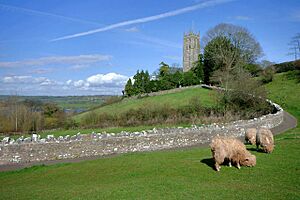John Langhorne (poet) facts for kids
John Langhorne was an English clergyman, poet, translator, editor, and author. He was born in March 1735 in Winton, a village in Cumbria, England. He passed away on April 1, 1779, in Blagdon, Somerset.
Life of John Langhorne
John Langhorne's father was also a clergyman. He died when John was only four years old. His mother made sure he went to school in Winton and then in Appleby. However, there wasn't enough money for him to go to university.
From age 18, John supported himself by teaching in various places in Yorkshire. He later became a tutor for the nine sons of Robert Cracroft at Hackthorn Hall in Lincolnshire. In 1761, he became a deacon, which is a type of church official. After working as a curate (a helper to a priest) in Dagenham, he became a curate and lecturer at St. John's, Clerkenwell in 1764. He was also appointed assistant preacher at Lincoln's Inn at the end of 1765.
Langhorne began to use his writing skills, especially as a reviewer for the Monthly Review. He was very supportive of the poet William Collins, whose poems were not well-known at the time. Langhorne published a collection of Collins's poems in 1765. This helped Collins become more famous later on.
In 1766, Langhorne published his own book, Poetical Works. That same year, he became the rector (head priest) of Blagdon. He was finally able to marry Ann Cracroft, with whom he had been writing letters since his time at Hackthorn Hall. Sadly, Ann died on May 4, 1768, after giving birth to their son, John Theodosius Langhorne.
After his wife's death, Langhorne left Blagdon. He stayed for a while with his elder brother William in Folkestone. Together, they translated Plutarch's Lives, a famous collection of biographies. Their translation was published in 1770 and was very popular, being reprinted many times.
In 1772, Langhorne married for a second time to Isabella Thomson. She was the daughter of a local official from Westmorland. Sadly, Isabella also died in 1776 after giving birth to their daughter, Isabella Maria Constantia.
Despite these personal losses, Langhorne's career continued to grow. He became a justice of the peace, a type of judge. At a friend's suggestion, he started writing his most important poem, The Country Justice. This poem was published in three parts between 1774 and 1777. In 1777, he was made a prebendary of Wells Cathedral, another important church role. John Langhorne died two years later at the age of 45.
John Langhorne's Writing
John Langhorne wrote many poems and prose works. They were popular during his time but quickly went out of style. One writer described his poetry as having "a delicious sweetness" and "tender and lovely sentiment."
Two of Langhorne's works are still remembered today.
Fables of Flora
His "Fables of Flora" (1771) were unique. In these fables, plants talk to each other to teach moral lessons. This was a new idea, though some older stories like Aesop's Fables also used animals or plants to teach lessons. Langhorne's plant stories were longer and used a lot of detailed descriptions.
The Country Justice
The Country Justice is considered Langhorne's most original poem. The publisher Robert Chambers said it was the only one of Langhorne's poems that truly showed his own style. He believed Langhorne was one of the first poets to describe English country life in a realistic way.
The famous poet William Wordsworth also greatly admired The Country Justice. He praised how the poem "brought the Muse into the company of common life." This meant it made poetry about everyday things and people.
Some people even think Langhorne's writing hinted at ideas that Wordsworth later explored, like connecting with nature. For example, Langhorne's "Inscription on the door of a study" encourages readers to go outside and learn from nature, saying:
-
- If Religion claims thy care,
- Religion, fled from books, is there.
- For first from Nature's works we drew
- Our knowledge and our virtue too.
This shows how Langhorne, like other poets of his time, started to move away from older styles and find new ways to express themselves through nature.


